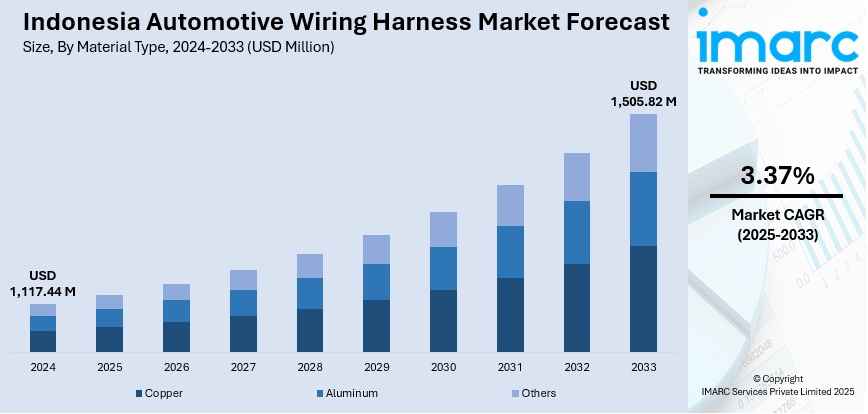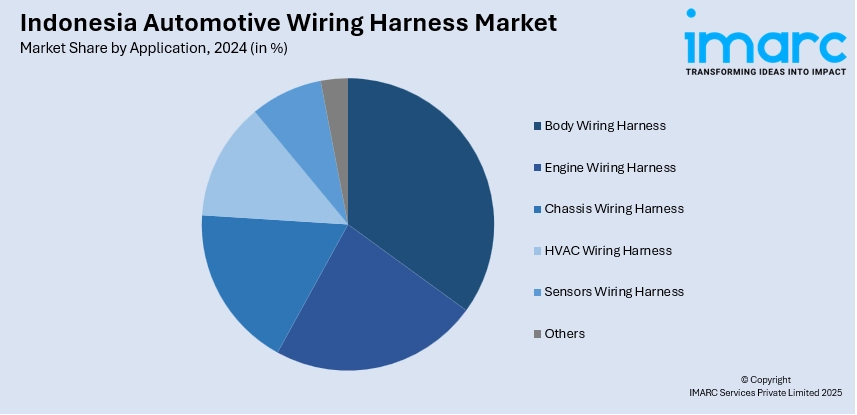
Indonesia Automotive Wiring Harness Market Size, Share, Trends and Forecast by Application, Material Type, Transmission Type, Vehicle Type, Category, Component, and Region, 2025-2033
Indonesia Automotive Wiring Harness Market Overview:
The Indonesia automotive wiring harness market size reached USD 1,117.44 Million in 2024. Looking forward, the market is expected to reach USD 1,505.82 Million by 2033, exhibiting a growth rate (CAGR) of 3.37% during 2025-2033. The market is advancing with local car assembly expansion, rising EV and hybrid vehicle introduction, and growing ADAS content. Cost-effective local labour and supplier joint ventures support supply chain scaling. Data‑heavy and power harnesses are key contributors of Indonesia automotive wiring harness market share.
|
Report Attribute
|
Key Statistics
|
|---|---|
|
Base Year
|
2024
|
|
Forecast Years
|
2025-2033
|
|
Historical Years
|
2019-2024
|
| Market Size in 2024 | USD 1,117.44 Million |
| Market Forecast in 2033 | USD 1,505.82 Million |
| Market Growth Rate 2025-2033 | 3.37% |
Indonesia Automotive Wiring Harness Market Trends:
Entry of EV Platforms and HV Harness Demand
By the end of 2024, Indonesia recorded around 195,000 EVs, with over 80% being electric motorbikes and roughly 16% electric cars. Battery EV sales more than doubled that year due to incentives like a 7 million IDR subsidy and VAT reductions. Automakers are introducing hybrid and battery electric platforms in Indonesia, increasing demand for high-voltage harnesses for batteries, motors, and charging systems. These modules require enhanced insulation, waterproof sealing, and thermal management adapted to tropical climate. Integration with onboard diagnostics and battery monitoring units is critical. Suppliers invest in validation rigs and safety testing to meet ISO 26262 and IEC automotive standards. The emergence of EV production lines accelerates the adoption of high‑voltage harness architectures. Consequently, Indonesia experiences a notable transformation in wiring harness technical complexity, underpinning Indonesia automotive wiring harness market growth.

To get more information on this market, Request Sample
Automation and Supplier Capability Enhancement
Indonesian wiring harness vendors are upgrading manufacturing capabilities through automation and lean processes. Robotic crimping, machine vision inspection, and semi-automated loom assembly improve precision and consistency. Traceability systems track batch-level production quality. Training initiatives elevate worker proficiency in global QA standards and technical design tools. Collaboration with international harness technology providers facilitates knowledge transfer. These developments enable competitive delivery to OEM assembly lines and reduce lead times. As firms modernize operations and enhance engineering competency, the domestic harness industry becomes more robust and scalable, driving Indonesia automotive wiring harness market growth. For instance, in February 2025, Lear Corporation finalized its acquisition of StoneShield Engineering, a company recognized for its expertise in robotics, automated taping, and high-voltage harness technologies. The move strengthens Lear’s E-Systems segment and supports its IDEA strategy aimed at driving innovation through digital and automated manufacturing processes.
Indonesia Automotive Wiring Harness Market Segmentation:
IMARC Group provides an analysis of the key trends in each segment of the market, along with forecasts at the country/regional level for 2025-2033. Our report has categorized the market based on application, material type, transmission type, vehicle type, category, and component.
Application Insights:

- Body Wiring Harness
- Engine Wiring Harness
- Chassis Wiring Harness
- HVAC Wiring Harness
- Sensors Wiring Harness
- Others
The report has provided a detailed breakup and analysis of the market based on the application. This includes body wiring harness, engine wiring harness, chassis wiring harness, HVAC wiring harness, sensors wiring harness, and others.
Material Type Insights:
- Copper
- Aluminum
- Others
A detailed breakup and analysis of the market based on the material type have also been provided in the report. This includes copper, aluminum, and others.
Transmission Type Insights:
- Data Transmission
- Electrical Wiring
The report has provided a detailed breakup and analysis of the market based on the transmission type. This includes data transmission and electrical wiring.
Vehicle Type Insights:
- Two Wheelers
- Passenger Cars
- Commercial Vehicles
A detailed breakup and analysis of the market based on the vehicle type has also been provided in the report. This includes two wheelers, passenger cars, and commercial vehicles.
Category Insights:
- General Wires
- Heat Resistant Wires
- Shielded Wires
- Tubed Wires
The report has provided a detailed breakup and analysis of the market based on the category. This includes general wires, heat resistant wires, shielded wires, and tubed wires.
Component Insights:
- Connectors
- Wires
- Terminals
- Others
A detailed breakup and analysis of the market based on the component have also been provided in the report. This includes connectors, wires, terminals, and others.
Regional Insights:
- Java
- Sumatra
- Kalimantan
- Sulawesi
- Others
The report has also provided a comprehensive analysis of all the major regional markets, which include Java, Sumatra, Kalimantan, Sulawesi, and others.
Competitive Landscape:
The market research report has also provided a comprehensive analysis of the competitive landscape. Competitive analysis such as market structure, key player positioning, top winning strategies, competitive dashboard, and company evaluation quadrant has been covered in the report. Also, detailed profiles of all major companies have been provided.
Indonesia Automotive Wiring Harness Market News:
- In May 2024, Yazaki and Toray Industries developed a recycled polybutylene terephthalate (PBT) resin specifically for automotive wiring harness connectors. Made using scrap from manufacturing processes, the resin matches the performance of virgin material while helping cut carbon emissions. This collaboration promotes sustainable manufacturing and aligns with circular economy and carbon reduction goals in the auto sector.
Indonesia Automotive Wiring Harness Market Report Coverage:
| Report Features | Details |
|---|---|
| Base Year of the Analysis | 2024 |
| Historical Period | 2019-2024 |
| Forecast Period | 2025-2033 |
| Units | Million USD |
| Scope of the Report |
Exploration of Historical Trends and Market Outlook, Industry Catalysts and Challenges, Segment-Wise Historical and Future Market Assessment:
|
| Applications Covered | Body Wiring Harness, Engine Wiring Harness, Chassis Wiring Harness, HVAC Wiring Harness, Sensors Wiring Harness, Others |
| Material Types Covered | Copper, Aluminum, Others |
| Transmission Types Covered | Data Transmission, Electrical Wiring |
| Vehicle Types Covered | Two Wheelers, Passenger Cars, Commercial Vehicles |
| Categories Covered | General Wires, Heat Resistant Wires, Shielded Wires, Tubed Wires |
| Components Covered | Connectors, Wires, Terminals, Others |
| Regions Covered | Java, Sumatra, Kalimantan, Sulawesi, Others |
| Customization Scope | 10% Free Customization |
| Post-Sale Analyst Support | 10-12 Weeks |
| Delivery Format | PDF and Excel through Email (We can also provide the editable version of the report in PPT/Word format on special request) |
Key Questions Answered in This Report:
- How has the Indonesia automotive wiring harness market performed so far and how will it perform in the coming years?
- What is the breakup of the Indonesia automotive wiring harness market on the basis of application?
- What is the breakup of the Indonesia automotive wiring harness market on the basis of material type?
- What is the breakup of the Indonesia automotive wiring harness market on the basis of transmission type?
- What is the breakup of the Indonesia automotive wiring harness market on the basis of vehicle type?
- What is the breakup of the Indonesia automotive wiring harness market on the basis of category?
- What is the breakup of the Indonesia automotive wiring harness market on the basis of component?
- What is the breakup of the Indonesia automotive wiring harness market on the basis of region?
- What are the various stages in the value chain of the Indonesia automotive wiring harness market?
- What are the key driving factors and challenges in the Indonesia automotive wiring harness market?
- What is the structure of the Indonesia automotive wiring harness market and who are the key players?
- What is the degree of competition in the Indonesia automotive wiring harness market?
Key Benefits for Stakeholders:
- IMARC’s industry report offers a comprehensive quantitative analysis of various market segments, historical and current market trends, market forecasts, and dynamics of the Indonesia automotive wiring harness market from 2019-2033.
- The research report provides the latest information on the market drivers, challenges, and opportunities in the Indonesia automotive wiring harness market.
- Porter's five forces analysis assist stakeholders in assessing the impact of new entrants, competitive rivalry, supplier power, buyer power, and the threat of substitution. It helps stakeholders to analyze the level of competition within the Indonesia automotive wiring harness industry and its attractiveness.
- Competitive landscape allows stakeholders to understand their competitive environment and provides an insight into the current positions of key players in the market.
Need more help?
- Speak to our experienced analysts for insights on the current market scenarios.
- Include additional segments and countries to customize the report as per your requirement.
- Gain an unparalleled competitive advantage in your domain by understanding how to utilize the report and positively impacting your operations and revenue.
- For further assistance, please connect with our analysts.
 Request Customization
Request Customization
 Speak to an Analyst
Speak to an Analyst
 Request Brochure
Request Brochure
 Inquire Before Buying
Inquire Before Buying




.webp)




.webp)












